Dracaena marginata makes a lovely tree indoors or outside, and is fairly easy to care for. In this post, I’ll show you all you need to know in order to be successful, and keep your Madagascar dragon tree thriving for decades to come.
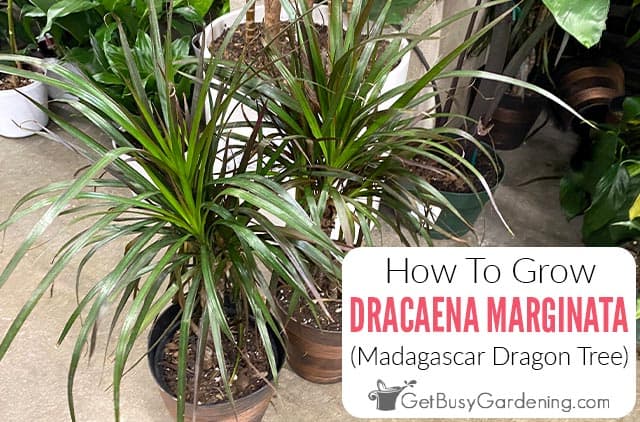
Home gardeners looking for a low-maintenance, beautiful houseplant will love a Dracaena marginata.
They’re very durable and adapt easily to many different light settings. Plus, the red and green foliage make them a stunning addition to your home!
In this detailed Dracaena marginata care guide you’ll discover just how simple they can be to grow.
In this complete guide, you’ll learn about the best soil, water, light, and how to maintain them through the years with pruning tips, propagation, pest control, and much more.
What Is Dracaena marginata?
Dracaena marginata, commonly called dragon tree, is an evergreen tropical plant that is native to Madagascar.
The slender, arching leaves are typically green with red margins. They grow in tufts at the end of one, or multiple, stems (aka canes).
As they age, the bottom leaves naturally drop off, leaving beautiful, diamond shaped patterns behind.
They can live for many years, and are even good for removing toxins from the air in your home.
Different Types Of Dragon Trees
The bicolored leaves on the common dragon tree are stunning. But other types show off color variations that are just as easy to love. Here are a few of my favorites.
- Dracaena marginata tricolor – These have three beautiful color stripes on the long leaves: green, yellow, and red.
- Dracaena colorama – The red edges are wider and lighter on this variety, creating near pink borders with a thinner green stripe in the middle.
- Variegated Dracaena marginata – This variegated type has a pale cream center surrounded by green, with a very narrow red edge.
- Dracaena marginata bicolor – Get the best of the variegated and the classic with the bicolor variety that features red edges with cream striping on the green leaves.
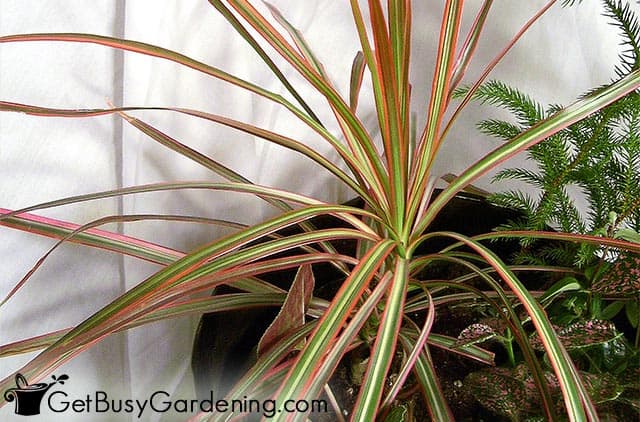
Dracaena marginata Flowers
Though very rare on indoor plants, Dracaena marginata can bloom. In the spring, small, fragrant white flowers can blossom from large, branching stalks.
As the flowers fade they’re followed by small red or orange berries that can contain viable seeds.
Dragon Tree Growth Rate
One of the most amazing things about dragon trees is their height. They can reach a towering 20’ tall!
Don’t worry about making room for a large tree just yet, however; they don’t grow fast. It can take a decade or more to reach their full height, and even longer when kept indoors.
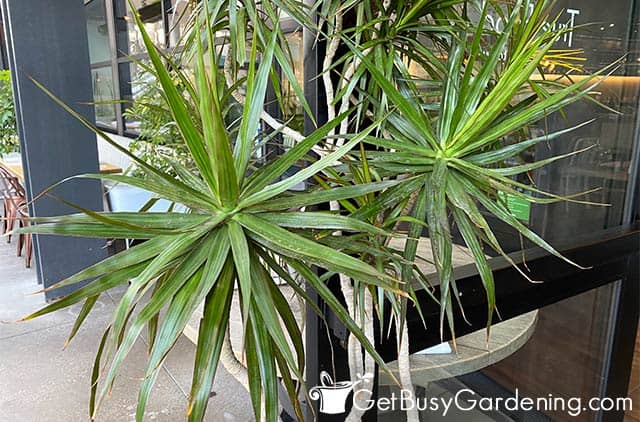
Toxicity
Unfortunately, dragon trees are toxic to dogs and cats when ingested, according to the ASPCA website. So if you have one, it’s best to keep them out of reach of your pets and small children.
How To Grow Dracaena marginata
Before we talk about how to care for Dracaena marginata, first let’s chat about the best growing environment. Choosing the right spot can help them live for decades.
Hardiness
Since they are perennials in their native climate, dragon trees can be kept outdoors year around in zones 10-12. But they will start to suffer if left outside once it gets below 60°F for long periods of time.
Freezing weather will quickly kill the foliage, and eventually the entire tree. So if you live in a cold climate, then you’ll have to bring it indoors during the winter.
Where To Grow A Dragon Tree
Dracaena marginata makes a great indoor plant year-round. Or, you can summer them outdoors, and move it back inside before the temperature drops below 60°F.
Indoors, a sunny south facing window would be ideal. But they can also do well with east or west facing exposure.
If you live in a warm enough area, you can leave them outside in a pot, or plant them directly in the garden. Choose a spot that has good drainage where they will receive direct sun in the mornings and evenings.

Dracaena marginata Care & Growing Instructions
Now that you have the perfect location in mind, it’s time to talk about Dracaena marginata care. The good news is that all of the different varieties will thrive using these growing tips.
Sunlight
Dragon trees are tolerant of a wide array of light levels. It’s part of why they’re so popular as office and houseplants.
But, they’ll grow faster and have more vibrant colors when given plenty of bright light. For best results indoors, keep them in a sunny window with as much direct exposure as possible.
If they start to get leggy or the colors are fading, then add a grow light to supplement.
Outdoors they do best in partial shade to full sun. Personally, I find they do better outside when they get direct sun in the mornings and evenings, but are protected from intense afternoon rays.
Water
Overwatering is the number one cause of unhealthy Dracaena marginata, they just don’t need that much.
When the soil is dry a couple of inches down, give them a deep drink, and drain off any excess. Never let them sit in water, and don’t keep the soil soggy.
It’s important to always check first to make sure they need it, rather than going by a schedule. I recommend an inexpensive soil moisture gauge to help you out.
The type of water you use also matters. Minerals and chemicals in tap water can cause brown tips on the leaves, so use distilled or rainwater instead, if possible.
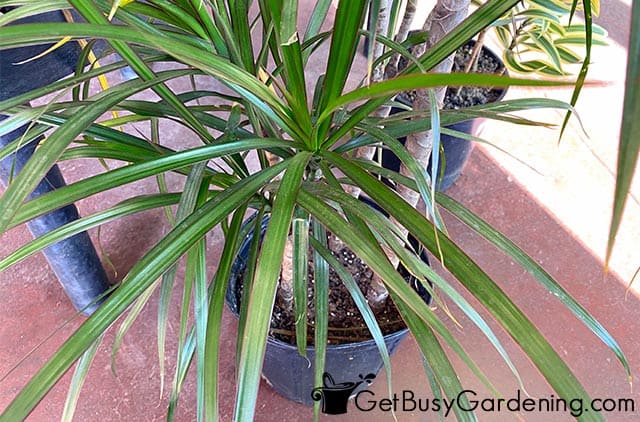
Humidity
They’re also tolerant of different humidity levels. Average household humidity is fine, but they can thrive with higher levels too.
Mist them occasionally if your home is particularly dry, or set them up on a pebble tray. You can also run a humidifier nearby to increase the moisture in the air.
Temperature
Dragon trees really prefer warmer temperatures. They’ll be happiest in the 60-80°F range, and can suffer leaf drop or even death if exposed to temps lower than that for too long.
In very hot arid climates or during a summer heatwave, they may need more frequent waterings, or a little more shade to keep them from burning.
Fertilizer
Dracaena marginata doesn’t require fertilizer as part of its regular care routine. But the occasional feeding can help them grow fuller and taller faster, and also keeps the colors brighter.
Only fertilize in the spring and summer, then stop in the fall and winter. Use water soluble indoor plant food or compost tea two to three times a year. You can also top-dress them with granules in the spring or early summer.
I recommend using only natural and organic products, and avoiding synthetic chemicals as they can easily burn the sensitive leaves.
Soil
Natively, Dracaena marginata grows in rocky, loose soil. So recreating that at home will keep them healthy. Ideally they prefer a slightly acidic well-draining, loamy soil with a pH of 6-7.
I recommend using a fast-draining sandy mix for them, especially if you tend to overwater.
You can make your own by combining equal parts potting soil with perlite or coarse sand. Adding a little peat moss is an easy way to increase the acidity.
Repotting
Since they are slow-growing, dragon trees don’t need frequent repotting for successful care. If you see a significant decrease in growth, or roots are poking through the drainage holes, it’s time to size up.
Choose a container just a few inches larger than the current one so it’s not overwhelmed by the space, and ensure it has adequate drainage holes in the bottom.
Plant it at the same depth as it was in the original pot, and use fresh soil to rejuvenate the nutrients.
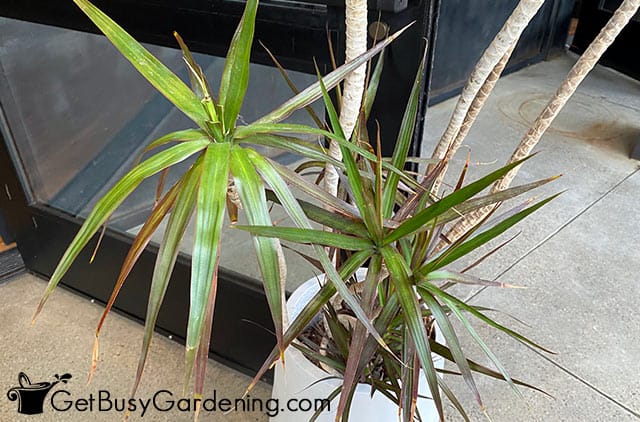
Pruning
There’s no need to prune your Dracaena marginata regularly. The bottom leaves will naturally turn yellow and fall off as new ones form, leaving only the top crown.
If yours is outgrowing its space or has become leggy, you can top it by cutting the entire crown and top part of the stem off.
The top can be rooted to create another plant, and new canes and leaves will develop from the remaining stem.
It’s also okay to trim off brown tips or discolored leaves as they appear. Use sharp precision pruners, and snip the tips at their natural angle to maintain the shape.
Pest Control Tips
Healthy Madagascar dragon trees rarely have issues with pests. But, from time to time mealybugs, scale, or spider mites can become a problem.
They’re all easily treatable with natural methods like an insecticidal soap, neem oil, or by dabbing the bugs with rubbing alcohol.
You can also make a homemade insecticidal spray by combining 1 teaspoon of mild liquid soap with 1 liter of water.
Madagascar Dragon Tree Propagation Tips
The most common way to propagate a Dracaena marginata is through stem cuttings. You can get one, or several, new trees depending on how much height you remove.
Use a sharp sterile pair of heavy duty clippers or a knife to remove the top crown and several inches of the cane.
Dust the cut end with rooting hormone, and plant it in well-draining, lightly moistened soil. You can also try rooting 3 inch segments of leafless cane pieces.
Troubleshooting Common Dracaena marginata Problems
Dracaena marginata doesn’t require much hands-on care, but over the years you may experience an issue or two. Here are my best tips for fixing the most common ones.
Leaf Tips Turning Brown
Brown leaf tips is easily the most common issue in Dracaena marginata care, and can be caused by several things.
Over or under watering, low humidity, too much fertilizer, and chemical or mineral build up in the soil could all be culprits.
Allow the soil to dry between waterings, and mist them on occasion if the air is very dry. Switch to natural, organic fertilizers rather than synthetic ones, and use distilled or rainwater instead of tap.
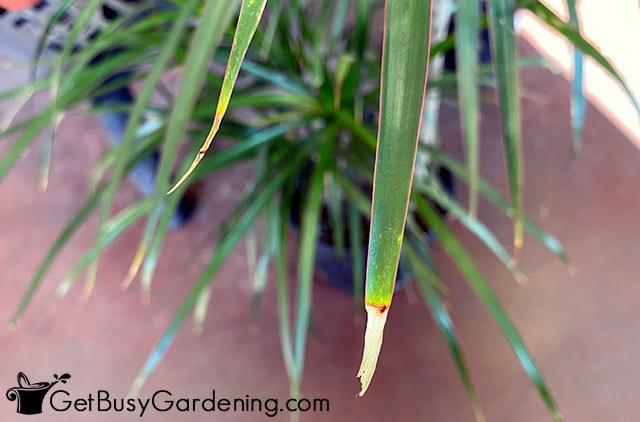
Dragon Tree Drooping
If your dragon tree is drooping it could be caused by improper watering, or sunlight and temperature problems.
The soil should dry out between waterings, but never to the point where it’s pulling away from the sides of the pot.
High heat or too much direct sun can also cause them to droop. Move it away from the window, or provide some shade outside during the hottest, brightest part of the day.
Leaves Falling Off
As they age, leaves will occasionally fall off the bottom of your Madagascar dragon tree, which is nothing to worry about. It’s a natural part of their life cycle to shed old leaves as new ones form.
However, if several leaves start falling off, especially from the top of the crown, it can mean your plant is unhealthy. Make sure you’re watering properly, and keep them away from drafts: either high heat, or freezing cold.
FAQs About Dracaena marginata Care
Here you’ll find my answers to some of the most commonly asked questions about Dracaena marginata care. If yours isn’t here, add it to the comments section below.
Is Dracaena marginata easy to care for?
Yes, Dracaena marginata is easy to care for. They don’t require much attention or water, and will thrive with a little neglect.
Does Dracaena marginata grow fast?
No, Dracaena marginata does not grow fast, especially in low light indoor settings. Even with the best care, it will take several years to get a sizable tree.
How do you make Dracaena marginata grow faster?
You can make Dracaena marginata grow faster with the proper care. Keep it in a bright light setting, water consistently, and fertilize a few times over the spring and summer.
How do you know when a dragon tree is dying?
You’ll know a dragon tree is dying when most of the leaves begin to yellow and fall off, especially on the top of the crown, or if the stem is soft or squishy.
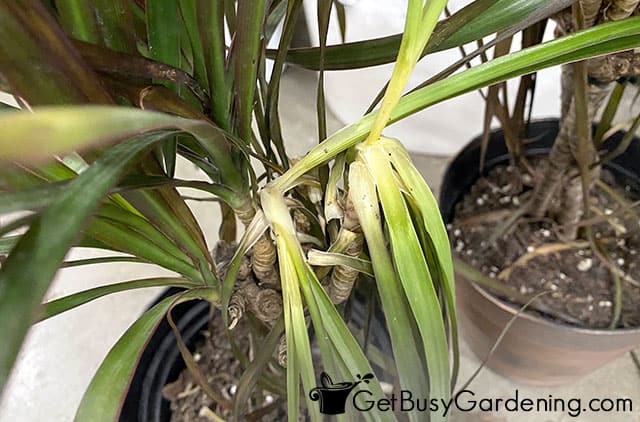
How often should you water a dragon tree?
How often you water a dragon tree depends on the temperature and light it’s given. Rather than keeping a set schedule, check the soil every few weeks, and water deeply when it’s dry a few inches down.
How much light does a dragon tree need?
A dragon tree needs a lot of bright light indoors, or partial to full sun outside. They are very tolerant of different levels. However, low light settings will slow their growth and dull the colors.
Now that you know how easy Dracaena marginata care is, growing one in your home or office will be a breeze. Just follow these tips, and you’ll enjoy yours for many, many years.
If you want to learn all there is to know about maintaining healthy indoor plants, then you need my Houseplant Care eBook. It will show you everything you need to know about how to keep every plant in your home thriving. Download your copy now!
More Houseplant Care Guides
- How To Care For Corn Plants (Dracaena fragrans)
- How To Care For Snake Plant (Mother-In-Law’s Tongue)
- How To Care For Fiddle Leaf Fig Plant (Ficus lyrata)
- How To Care For Sago Palm Trees (Cycas revoluta)
- Palm Plant Indoor Care – The Ultimate Care Guide For Your Palm Plant
- How To Care For Black Pagoda Lipstick Plant
Share your Dracaena marginata care tips in the comments section below.


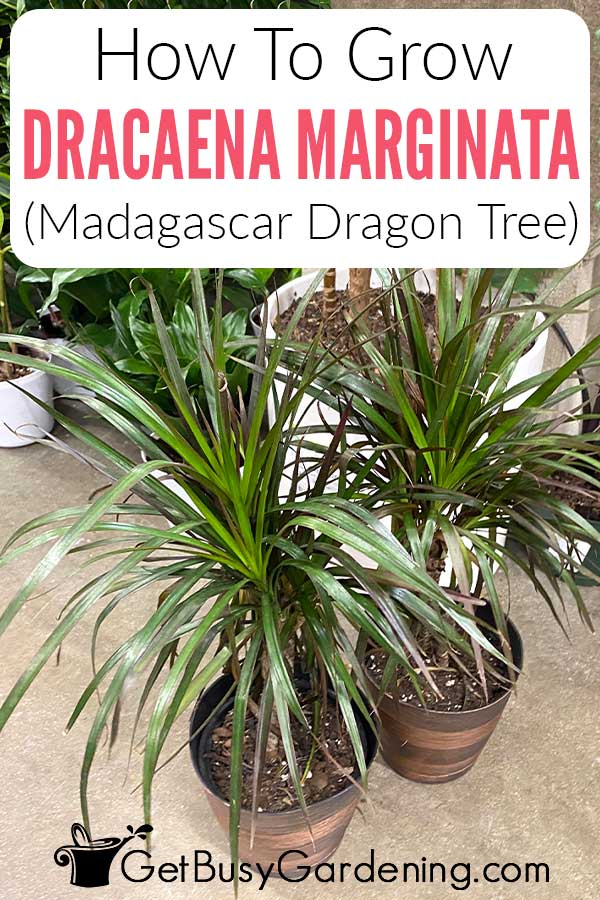



Leave a Reply